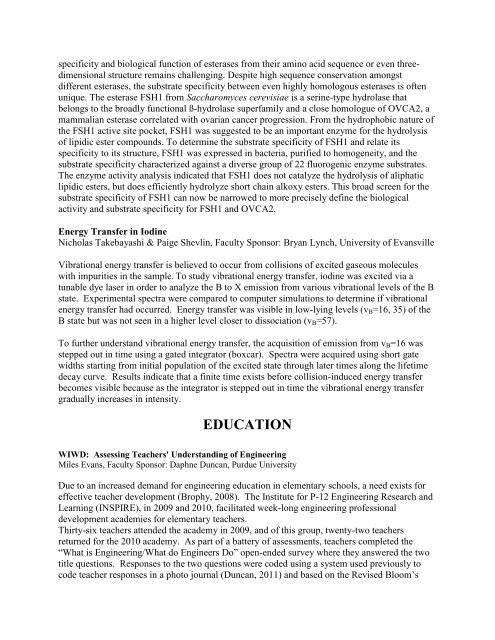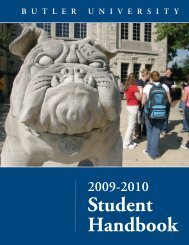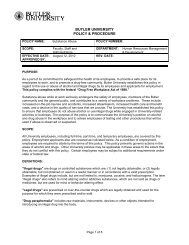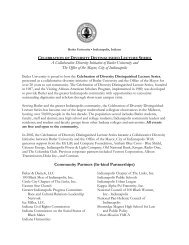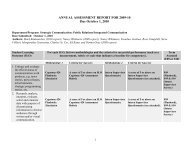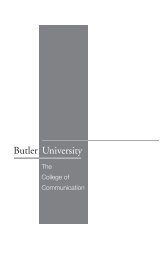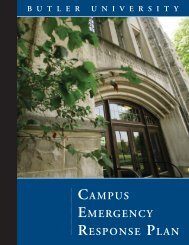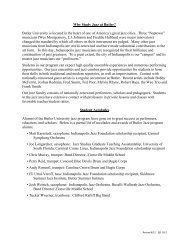Anthropology - Butler University
Anthropology - Butler University
Anthropology - Butler University
You also want an ePaper? Increase the reach of your titles
YUMPU automatically turns print PDFs into web optimized ePapers that Google loves.
specificity and biological function of esterases from their amino acid sequence or even threedimensional<br />
structure remains challenging. Despite high sequence conservation amongst<br />
different esterases, the substrate specificity between even highly homologous esterases is often<br />
unique. The esterase FSH1 from Saccharomyces cerevisiae is a serine-type hydrolase that<br />
belongs to the broadly functional ß-hydrolase superfamily and a close homologue of OVCA2, a<br />
mammalian esterase correlated with ovarian cancer progression. From the hydrophobic nature of<br />
the FSH1 active site pocket, FSH1 was suggested to be an important enzyme for the hydrolysis<br />
of lipidic ester compounds. To determine the substrate specificity of FSH1 and relate its<br />
specificity to its structure, FSH1 was expressed in bacteria, purified to homogeneity, and the<br />
substrate specificity characterized against a diverse group of 22 fluorogenic enzyme substrates.<br />
The enzyme activity analysis indicated that FSH1 does not catalyze the hydrolysis of aliphatic<br />
lipidic esters, but does efficiently hydrolyze short chain alkoxy esters. This broad screen for the<br />
substrate specificity of FSH1 can now be narrowed to more precisely define the biological<br />
activity and substrate specificity for FSH1 and OVCA2.<br />
Energy Transfer in Iodine<br />
Nicholas Takebayashi & Paige Shevlin, Faculty Sponsor: Bryan Lynch, <strong>University</strong> of Evansville<br />
Vibrational energy transfer is believed to occur from collisions of excited gaseous molecules<br />
with impurities in the sample. To study vibrational energy transfer, iodine was excited via a<br />
tunable dye laser in order to analyze the B to X emission from various vibrational levels of the B<br />
state. Experimental spectra were compared to computer simulations to determine if vibrational<br />
energy transfer had occurred. Energy transfer was visible in low-lying levels (v B =16, 35) of the<br />
B state but was not seen in a higher level closer to dissociation (v B =57).<br />
To further understand vibrational energy transfer, the acquisition of emission from v B =16 was<br />
stepped out in time using a gated integrator (boxcar). Spectra were acquired using short gate<br />
widths starting from initial population of the excited state through later times along the lifetime<br />
decay curve. Results indicate that a finite time exists before collision-induced energy transfer<br />
becomes visible because as the integrator is stepped out in time the vibrational energy transfer<br />
gradually increases in intensity.<br />
EDUCATION<br />
WIWD: Assessing Teachers' Understanding of Engineering<br />
Miles Evans, Faculty Sponsor: Daphne Duncan, Purdue <strong>University</strong><br />
Due to an increased demand for engineering education in elementary schools, a need exists for<br />
effective teacher development (Brophy, 2008). The Institute for P-12 Engineering Research and<br />
Learning (INSPIRE), in 2009 and 2010, facilitated week-long engineering professional<br />
development academies for elementary teachers.<br />
Thirty-six teachers attended the academy in 2009, and of this group, twenty-two teachers<br />
returned for the 2010 academy. As part of a battery of assessments, teachers completed the<br />
“What is Engineering/What do Engineers Do” open-ended survey where they answered the two<br />
title questions. Responses to the two questions were coded using a system used previously to<br />
code teacher responses in a photo journal (Duncan, 2011) and based on the Revised Bloom’s


